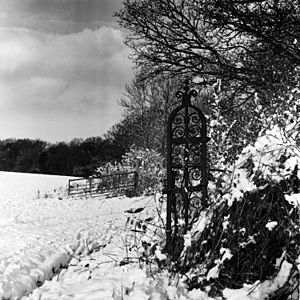Lord John Grey (Tudor nobleman) facts for kids
Lord John Grey (born around 1523 or 1524 – died November 19, 1564) was an English nobleman who lived during the time of the Tudor kings and queens. After 1559, he lived at Pirgo Place in Essex.
Lord John faced serious trouble for being involved in Wyatt's Rebellion against Queen Mary I. He was even sentenced to death, but he was later set free. Queen Elizabeth I, who became queen after Mary, brought him back into favor. She gave him Pirgo Place and made him the guardian of his niece, Lady Katherine Grey. Katherine was the sister of the famous Lady Jane Grey. However, Lord John was put in prison again shortly before he died. This happened because he published a book that said Katherine Grey should be the next queen of England.
Contents
Early Life
Lord John Grey was the youngest son of Thomas Grey, 2nd Marquess of Dorset. His mother was Margaret Wotton. Because his father was a marquess, John was given the special title "Lord." His older brothers, Henry Grey and Lord Thomas Grey, were punished severely in 1554.
Family Life
Lord John married Mary Browne. Together, they had three sons and four daughters.
- Henry Grey, 1st Baron Grey of Groby was their oldest son. He helped the Grey family become important again at court and in their family lands.
- Margaret Grey married Sir Arthur Capell. She was known for having many children.
- Frances Grey married Sir William Cooke.
- Elizabeth Grey married Sir Henry Denny.
- Jane Grey married Sir Edward Greville.
Working for the King
Lord John was given an important job in France. He became the leader of the English fortress in Newhaven (now Le Havre). He also received land from King Edward VI. These lands included areas in Leicestershire, Derbyshire, and Nottinghamshire. Queen Mary I later confirmed these land grants.
Trouble with Queen Mary
Lord John Grey and his brothers got involved in Wyatt's Rebellion. This rebellion wanted to replace the Catholic Queen Mary with her Protestant half-sister, Elizabeth. For his part in this, Lord John was condemned to death. His brothers, Henry and Thomas, lost their lives. But with help from his brother-in-law, Lord John Grey was released. He had lost many of his rights and property, but he lived quietly until Queen Mary died.
As the only surviving son of his father, Lord John should have inherited his family's title. However, because of his involvement in the rebellion, the title was taken away in 1554. This meant he could not be part of Parliament. His niece, Lady Jane Grey, had already been condemned and lost her life the month after the rebellion.
Back in Favor with Queen Elizabeth
When Queen Elizabeth I became queen, Lord John was called to her court. He attended her first trip into London and gave her a valuable gift. A few months later, he told Queen Elizabeth's chief minister, Lord Burghley, that he was poor. The Queen then gave him the royal land and house of Pirgo in Essex. She also gave him lands in Somerset.
Queen Elizabeth also restored his rights. This meant he got back the rights he had lost after the rebellion. He was also chosen as one of four Protestant noblemen to help change the Book of Common Prayer, which was an important religious book.
Looking After Lady Katherine
Lord John's niece, Lady Katherine Grey, was Lady Jane Grey's younger sister. She was considered a possible heir to the English throne. In 1560, Katherine secretly married Edward Seymour, 1st Earl of Hertford without the Queen's permission. When the Queen found out, Lady Katherine Grey was sent to The Tower.
In 1563, Katherine was allowed to leave the Tower because of a plague outbreak. She was moved to Pirgo Place and placed under Lord John Grey's care. However, a book started circulating that claimed Lady Katherine was the rightful heir to the English throne, not Mary, Queen of Scots. Because of this, Queen Elizabeth took Katherine away from Lord John's care and briefly put him in prison.
Later Life and Death
Lord John Grey died a short time later at Pirgo on November 19, 1564. He was buried in the chapel on the estate. The chapel was later taken down.
Family Symbol
The Grey family's coat of arms, which is like their family symbol, is described as having six horizontal stripes of silver and blue. At the top, there are three red circles.
See also
- Marquess of Dorset
- Earl of Stamford
- House of Grey



